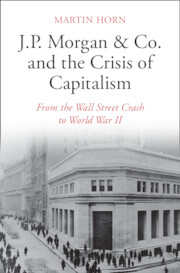Book contents
- J.P. Morgan & Co. and the Crisis of Capitalism
- J.P. Morgan & Co. and the Crisis of Capitalism
- Copyright page
- Dedication
- Contents
- Figures and Tables
- Acknowledgements
- Introduction
- 1 “The Heart of Contemporary Capitalism”
- 2 J.P. Morgan & Co. at Home and Abroad in the 1920s
- 3 The Young Plan, the Bank for International Settlements, and the Wall Street Crash, 1929–1930
- 4 “The End of the World”? The 1931 Crises
- 5 “Witchcraft”: J.P. Morgan & Co., Hoover, and the Depression in the United States, 1930–1933
- 6 “In the Storm Cellar”: J.P. Morgan & Co. and the New Deal, 1933–1936
- 7 J.P. Morgan & Co. and the Foreign Policy of the New Deal
- 8 The Coming of War and the End of the Partnership, 1937–1940
- Conclusion
- Appendices
- Bibliography
- Index
6 - “In the Storm Cellar”: J.P. Morgan & Co. and the New Deal, 1933–1936
Published online by Cambridge University Press: 17 February 2022
- J.P. Morgan & Co. and the Crisis of Capitalism
- J.P. Morgan & Co. and the Crisis of Capitalism
- Copyright page
- Dedication
- Contents
- Figures and Tables
- Acknowledgements
- Introduction
- 1 “The Heart of Contemporary Capitalism”
- 2 J.P. Morgan & Co. at Home and Abroad in the 1920s
- 3 The Young Plan, the Bank for International Settlements, and the Wall Street Crash, 1929–1930
- 4 “The End of the World”? The 1931 Crises
- 5 “Witchcraft”: J.P. Morgan & Co., Hoover, and the Depression in the United States, 1930–1933
- 6 “In the Storm Cellar”: J.P. Morgan & Co. and the New Deal, 1933–1936
- 7 J.P. Morgan & Co. and the Foreign Policy of the New Deal
- 8 The Coming of War and the End of the Partnership, 1937–1940
- Conclusion
- Appendices
- Bibliography
- Index
Summary
Histories of the interaction between business and the New Deal have emphasized a movement from concord, to doubt, to full-blown animosity by 1935–36. The advent of the American Liberty League is often seen as emblematic. For J.P. Morgan & Co. the New Deal was fracturing – in its banking business, in its politics, and among its partners. While the Pecora hearings dominated American media in May-June 1933, Glass–Steagall was the fulcrum on which the Morgan bank and the New Deal pivoted. Glass–Steagall dictated that J.P. Morgan & Co. must make a choice between commercial and investment banking. From the late summer of 1933 Morgan efforts were bent to securing its revision. Unable to secure modification of Glass–Steagall, the Morgan partners split on their appreciation of Roosevelt and the New Deal. Jack Morgan became a strident critic, while Leffingwell argued that the New Deal had saved capitalism. Simultaneously, the partners, reeling, became ever more cautious as bankers, embracing a conservatism that reflected their hope that the provisions of Glass–Steagall would not be implemented. When this failed, they created Morgan Stanley as an independent investment bank as a temporary adaptation.
- Type
- Chapter
- Information
- J.P. Morgan & Co. and the Crisis of CapitalismFrom the Wall Street Crash to World War II, pp. 207 - 260Publisher: Cambridge University PressPrint publication year: 2022



